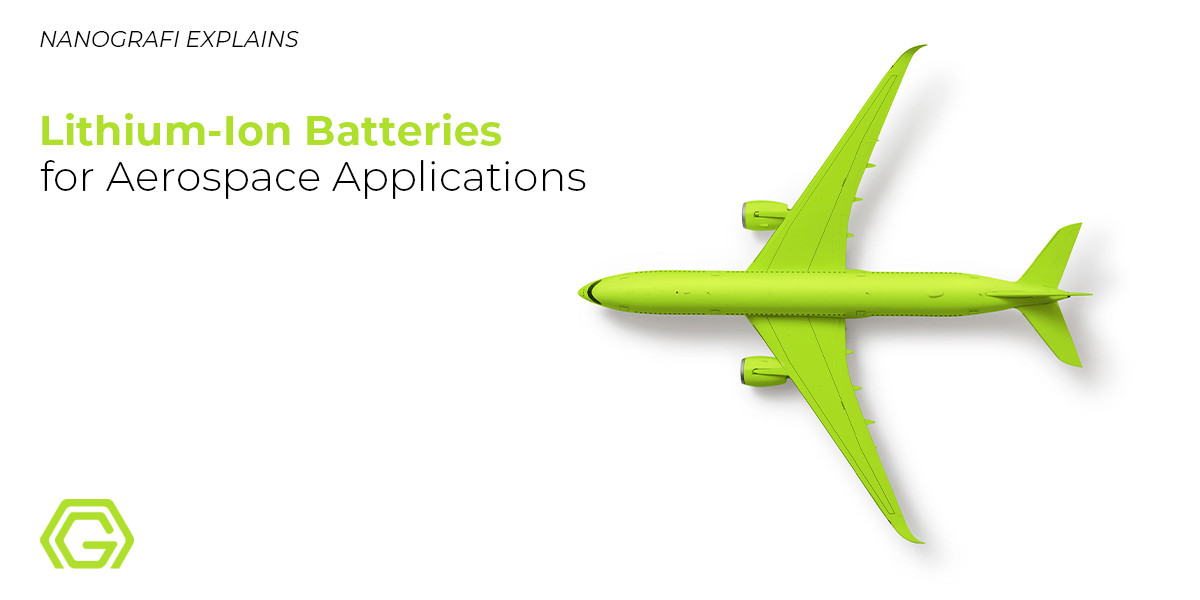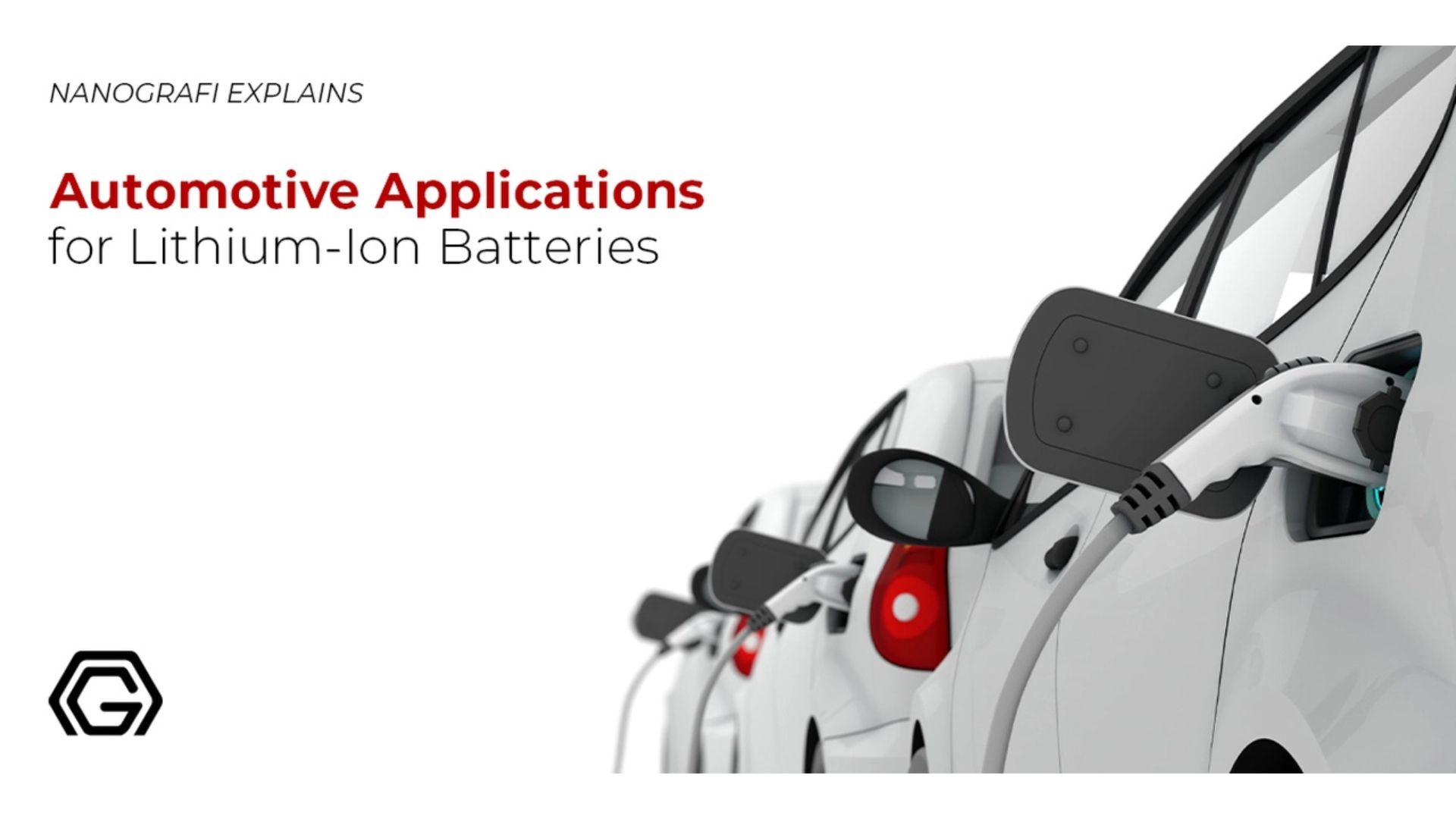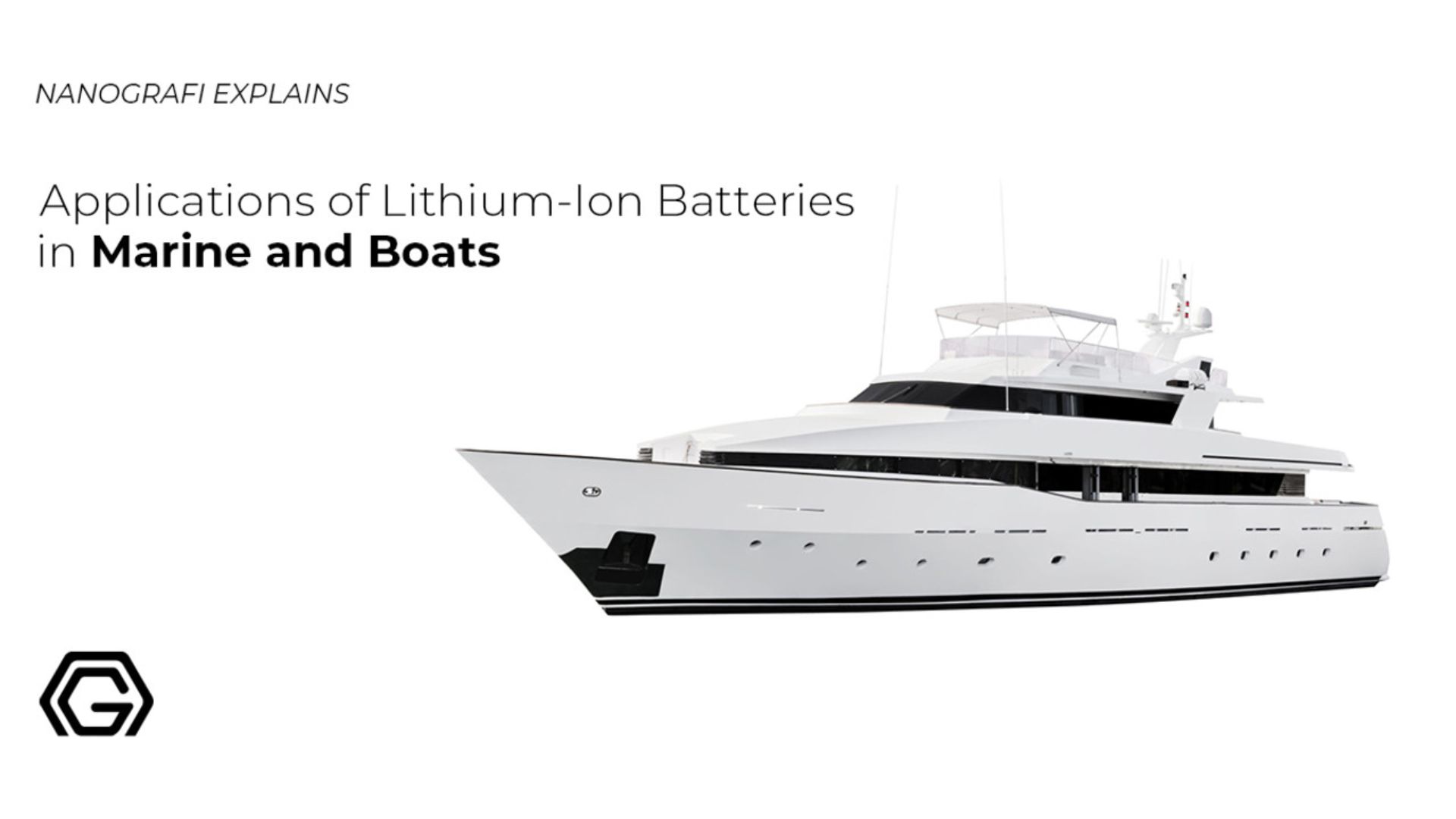Lithium-Ion Batteries for Aerospace Applications
Lithium-ion batteries are a kind of rechargeable batteries having lithium as the most integral component as the name suggests.
These batteries are highly efficient in their work performance owing to the excellent characteristics and properties that they are capable of exhibiting. A lot of recent developments have been made in terms of aerospace applications regarding the li-ion batteries as aerospace is one of those very industries in which li-ion batteries are making huge progress through their authenticity and are enhancing the quality of this entire field. The different researches that have been carried out are proof of the advancements that have been declared so far.
Introduction
A lithium-ion battery typically known as a li-ion battery is one of the types of rechargeable batteries comprising lithium ions that move from the negative end of the electrode towards the positive end with the help of an electrolyte during the process of discharge and then back again during the process of charging. These batteries use intercalated lithium compound is used at the positive end whereas graphite is used at the negative end of the electrode.
High Energy Density
Li-ion batteries have a high energy density whereas they do not possess any memory effect and have a low self-discharge capacity. Cells are capable of exhibiting either energy or power density after going through the process of manufacturing while it is also important to keep everything else around in consideration as they can be a safety hazard in terms of having flammable electrolytes.
Development of Li-ion Battery
The first li-ion battery to be ever discovered was a prototype li-ion battery whose development was carried out by Akira Yoshino in 1985 which was based on research that was first carried out by John Goodenough, M. Stanley Whittingham, Rachid Yazami, and Koichi Mizushima in the early 1970s and 1980s. Afterward, a commercial li-ion battery came into existence in 1991 by a team led by Yoshio Nishi. These batteries are most commonly used for portable electronics as well as electric vehicles and are showing massive growth in aerospace applications.
Characteristics of Lithium-Ion Batteries
The characteristics of li-ion batteries are the ones that make these batteries one of a kind as they play an integral role in enhancing their productivity and work mechanics. Their characteristics do vary from each other and at different levels but that does not play a role of hindrance in their performances. Different types of products use different types of lithium-ion batteries depending upon the quality of the battery that their product is in demand. In this way, the products can function in much better ways and provide better outcomes as all their needs and requirements will be fulfilled.
Further Research Areas for Li-Ion Batteries
There are a lot of different research areas for the li-ion batteries which include the extension in their lifetime, and increase in the energy density. Safety improvement, reduction in the cost, and increase in the charging speed are the most common ones among all the others. Research is also being carried out so that the non-flammable electrolytes can be used as a pathway so that the safety measurements can be enhanced to provide a better and quality environment for these lithium-ion batteries to work freely and gain better outcomes than they already are.
Present Day Lithium Ion Batteries
Lithium-ion batteries have been on the market for a lot of years now but the present-day li-ion batteries are a bit more complicated as their use and working dynamics have drastically changed over the years. Also, the small electronic devices are rather less complicated and a lot of additional markets have been opened up for them now to carry out the tasks that they can handle. However, the li-ion batteries are capable of possessing much higher power than what had been originally suspected about them.
High Energy Cells
High energy cells are very important for the better functioning of these lithium-ion batteries as they add up to the value of these batteries by increasing their battery life which ultimately improves and elongates their functioning properties. Initially, the high-energy cells that were being used in the lithium-ion batteries were not much updated but as time evolved, their energy cells evolved too so that a better product can come into existence and serve for a longer period than it already is.
Development of Ceramic Coatings
One of the recent developments in the use of ceramic coatings to the separator or at other times to the positive electrode as it has a beneficial effect which is the prevention of short circuits during any sort of ongoing process. This is possible through the working of metal particles which are present on the surface of electrodes as they are very small in size and their working results are great as they are airborne. Nonetheless, these ceramic coatings are proved to be highly beneficial for the li-ion batteries and also play a role in maintaining their credibility and enhancing their working capabilities.
Additional Advantages
There are a lot of additional advantages as well for the coating of the separators so that the working ethics can be enhanced at greater levels. Weak short circuits will be degraded by promoting better cycling without any safety incident being taken place and electrolyte wetting to be improved. Complex coatings are also beginning to become a norm for example in Tesla Motors so that the penetration strength of the coating can be increased massively.
Lightweight Vehicles
In regards to the environmental protection agency, lightweight vehicles including personal cars and rides are considered the best contributors to greenhouse gas emissions in the United States. However, all the contribution of the emission that comes out from the aviation industry is not to be missed at all so different types of examinations are to be carried out in this field. The government and all the other interrelated fields are looking for ways in which these adversities can be minimized for a better outcome and future of the industries.
To get more information about the application areas of Lithuim-ion batteries,
you can read our blog post here.
Lithium-Ion Batteries in Aerospace Industries
After the research that was carried out in this regard, it was noted that the li-ion batteries put emphasis on curtailing emissions and made it possible through various advancements which ultimately led to the creation of high energy density batteries. Once the fuel burn is added during the flight operations, major differences can be seen in the amount of greenhouse gas that is emitted into the atmosphere. Li-ion batteries have proved to be highly beneficial for the aerospace industries and thus add up to aerospace applications.
Transformative Battery Technologies
Although, numerous challenges have resulted in creeping progress toward the realization of the all-electric aircraft despite various efforts of integrating the transformative battery technologies into the vehicle propulsion architectures. Some of these complications are from the oversimplifications that were made during the new aircraft's conceptual design stage. For example, using the models that can't capture the electrical load modulation experienced in flight and pack-level assumptions made when there are estimations of the cell temperature being made, can lead to disagreement between the battery experts and aircraft designers on the electrochemical cell's performance ceilings.
Urban Air Mobility Operations
In urban air mobility (UAM) operations, this disconnect will be more apparent, and that aims for deploying the electric vertical takeoff and landing of the (EVTOL) aircraft, consuming energy in large amounts during departure procedures and transitioning approach. Realistic UAM operations can result in significant departures from the standard EVTOL power profiles, because of the congestion at vertiports, weather-related alternative landings, and go-around maneuvers.
Challenges with Electrochemical Cell
Various challenges are associated with the electrochemical cell. Production of a nonflammable, safe electrolyte with a large operating window is included in these along with the inclusion of the production of an amorphous solid/electrolyte-interface (SEI) layer which is developed due to repeated cycling. The electrode and electrolyte become more reactive when the cell is completely charged during each cycle and can form a reaction with each other, thus making this passivating SEI layer containing lithium.
Byproduct's Utilization
Despite the coating and protection of the electrodes by the byproduct preventing further corrosive reactions, it is still reversible. Lithium ions consumption for forming this SEI layer lessens the ionic concentration for facilitating the energy storage, leading to a lessening in the complete energy capacity. Failure in capturing this diminishing behavior can result in the overprediction of system-level performance, which can result in the electric vehicle's inability (EV) of meeting its estimated range. Battery life studies, as a result, must be a significant practice to evaluate long-term flight operations and estimate market potential.
Categorizing the Lithium–Ion Batteries
In comparison with the other battery technologies like lithium-air and molten salts, the reliability in performance coupled with high power and energy densities have resulted in the rechargeable lithium-ion batteries being the best energy source for electric vehicles. Development and testing the battery packs based on this kind of technology is easier now because of the low cost of manufacturing, and high demand, usually driven by the automotive industry and consumer electronics. Electrochemical cells' primary components are an anode, cathode, electrolyte, and current collectors. Usually, an electrolyte connected to the current collectors separates an anode and a cathode.
Electrical Discharge
There is simultaneous diffusion of the lithium ions occurring within the cell through the electrolyte from anode to cathode during the electrical discharge to an externally connected circuit. Commercially, the Li-ion cells are made for EV applications as either jelly-rolled cylindrical cells or prismatic pouch cells (made as a current collector, and successive layers of the electrode, and electrolyte). Both possess various disadvantages and advantages.
For instance, a large surface area is possessed by the pouch cell, making it appropriate for cooling, but it needs a heavy protective case which adds a major weight to the total battery pack. Durability is offered by the cylindrical cell on the other hand but at a low packaging density. There is a usage of a Chemical compound with a long cycle life at the positive electrode, it also further classifies the lithium-ion batteries, the best negative electrode today is graphite.
Aerospace Applications of Lithium-Ion Batteries
Although weight is a limiting factor in aerospace applications, the cathodic chemistries like lithium–nickel– cobalt–aluminum-oxide (stoichiometry: LiNiCoAlO2, abbreviated NCA) and lithium–nickel–manganese–cobalt-oxide (stoichiometry: LiNiMnCoO2, abbreviated NMC), are preferred. Like the NCA cell, similar power and energy density are possessed by the NMC cell, but its performance is better than the NCA cell in terms of cost and safety of sourcing raw materials for manufacturing the cell. The cylindrical NMC cells made by Panasonic are utilized in this study in the lithium-ion cell's computational model.
To get more information about marine applications of lithium-ion batteries,
you can read our blog post here.
Current State of the Lithium–Ion Battery
An electrochemical cell is defined as the stored energy's smallest independent source and a battery module is a collection of these cells that are connected in some regular arrangement electrically. Modules make up a battery pack for forming an electric vehicle's unified energy source. Moreover, SOC is the energy that remains within a single cell or a complete battery pack as a percentage of the state that is completely charged, meanwhile the SOH refers to the figure of the merit of the battery's condition comparative to its initial (ideal) condition.
Estimation of both the SOH and SOC of individual cells in the pack in the electric vehicles is the responsibility of the battery management system (BMS). Also, an ideal temperature range is possessed by all of the batteries for optimum operation. The energy capacity of the battery decreases below this range and the safety hazard's potential considerably heightens above this range. In lithium-ion battery usage, thermal runaway is a significant issue because of these explosions' catastrophic nature and the speed at which fires can erupt.
Temperature Controlling
Monitoring and controlling the battery's temperature by thermal management system is very important as it guarantees an operation within safe margins for prolonging the cycle life. The behavior of the cell should not be characterized at optimum conditions only for designing a robust BMS, but should also be described in the off-design conditions reflecting the fluctuations in temperature around the world in various geographical locations. Cities having cold climates are included in this because of the altitude or latitude (like Denver in the United States, and Moscow in Russia), along with the cities like Sydney, Australia, where the temperature can rise over 104°F (40°C).
Flight Profile Simulation
A root-finding algorithm from the Scientific Python (known as SciPy) package is run to obtain the aircraft's performance throughout the mission for solving the kinematic equations of motion and the mechanical–electrical relationship which equates the power that is drawn by the motors to the power that the battery supplies. The internal resistance of the battery generates heat which is coupled with the SOC and its operating environment, which is increased at higher discharge/charge rates. Solving for the electrical state variables was simultaneously done consequently with the equation system displaying the aircraft's force balance.
Nonlinear Throttle Profiles
There is a rise in the nonlinear throttle profiles as the aircraft climbs through the varying density atmosphere by the vehicle meets the accelerations and velocities specified in the mission profile setup. In long-duration segments, there was a predominant rise of the high recorded values of Q, where very little current was drawn from the battery. The largest amounts of heat are generated within the battery module by segments that need large amounts of power like the initial climb area, departure end of the runway, and takeoff.
Battery Sensitivity to Environmental Conditions and Flight Profile
It is indicated by the preliminary results that the battery's discharge history heavily determines the performance of the aircraft. As the internal structure of the battery degrades, there will also be a change in the extent to which the battery ages, leading to changes in the current and voltage loads needed for performing similar maneuvers. Almost 48 hours of wall-clock run time was taken by the full-calendar-year simulation on one CPU. Thus it is recommended that any attempt at battery or vehicle optimization should be executed first through the response surfaces creation. Appropriate values for discontinuous variables like the number of cells in series and parallel and continuous variables like the spacing between the individual battery cells within the module are determined by using subsequent algorithms.
Stimulated Ranges of Flights
55 miles was each flight's per simulated day range, comprising a 10% emergency maneuver and a nominal 50 miles flight radius from San Francisco International Airport. Near cities of Napa, Palo Alto, Oakland, and San Jose are encompassed in this range, implying that the battery is charged at 3.55 A of current or equivalent, thus 1 hour will be taken by the battery for charging from 0 SOC to 1 SOC. This model also captured the recharging impact on the battery life. In the future, we will quantify the fast charging effect on battery life. There was the omission of the approach (DL, BL, FA, L, and RT) and airport departure (TO, ICA, and DER) segments from the range credit. The National Centers for Environmental Information obtained the ambient temperature that's utilized in the heat transfer model of the module. Due to altitude change, the temperature offsets as during the flight, the aircraft climbs and descends.
Enabling Technologies
In the design process, battery modeling is a significant component with lithium-ion batteries being the enabling technology for the certification of electric vehicles. This study's main aim was to bridge the gap between the body of the existing literature on lithium-ion battery analysis and the world of conceptual electric aircraft design. A comprehensive model was proposed in this paper which encompassed the cell and pack's degradation, thermal, and electrical characteristics for aerospace applications.
Modeling of a Realistic Flight Profile
When accurate modeling is provided and presented by a realistic flight profile, it is observed that the overall battery energy is reduced by 25% for electrical general aviation. This happens after a full calendar year of the entire operation. These findings suggest that it is very important to take the appropriate sizing of a battery pack into consideration while being in the process of medium-fidelity battery modeling. This entire process contains an assumption that the constant specific heat capacity is used for the characterization of thermal load in the case of NMC cell. However, the facts cylindrical batteries are the ones that are used in this work and go through the process of manufacturing with the help of placement of multiple layered electrodes and a diaphragm into the electrolyte. All of this structure is designed in the spiral structure form which is responsible for making the conductivity inside the battery anisotropic.
Application of the Methodology
It is to be noted that in the model presented in the above-mentioned study, specificity is provided to the cylindrical NMC cells however, this same methodology can be applied to other types of cells as well when they are provided with the empirical information so the discharge and aging models can be updated in time.
Area of Future Work
There are a lot of future work areas for this process and one of those is battery modeling present within the modules inside the thermal zones so that the cells can be divided. When we look at the aircraft stimulation side, there is still room for the need of improvement in the case of realistic flight profiles. In this way, the battery life can be enhanced in certain ways to last longer for better working mechanics and ultimately a rise in the economy and industries.
Conclusion
Lithium-ion batteries are the most used and renowned batteries that our industries use for better productivity and commercialization purposes. Aerospace industries have recently joined this category where li-ion batteries have been providing them with stability and better productivity chances through their excellent properties and characteristics which they offer to the industries to enhance the overall aerospace applications.
To get more information, you can visit Blografi.
References
https://suave.stanford.edu/publications/2021_Battery_Degradation_Modeling.pdf
https://trs.jpl.nasa.gov/bitstream/handle/2014/10116/02-2055.pdf?sequence=1
https://www.sciencedirect.com/science/article/abs/pii/S0378775301005845
https://www.researchgate.net/publication/3277939_Lithium-ion_batteries_for_aerospace/link/54872e580cf289302e2ed598/download
https://cutt.ly/AZD5335
Recent Posts
-
Turning Noise into Power: Energy Harvesting with Piezoelectric Nanogenerators
Ambient acoustic energy, once an untapped resource, is now being converted into sustainable electric …5th Mar 2025 -
Holey Super Graphene in Li-ion Batteries: Next Generation of Energy Storage
Holey Super Graphene (hG), also referred to as “holey graphene,” is redefining li-ion ba …7th Feb 2025 -
Future Communication with 5G Technology and Advanced Materials
5G technology opens the doors to a new era in communication with faster connection speeds, low laten …6th Feb 2025








